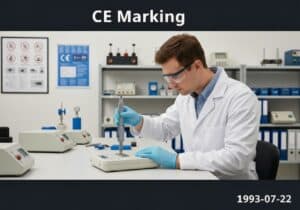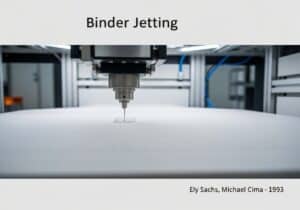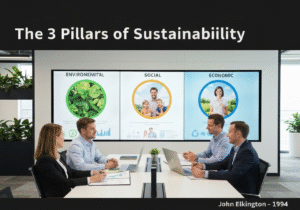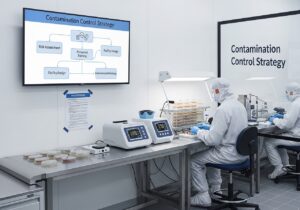Did you know that plastic makes up 60% to 80% of marine waste? Shockingly, 90% of floating waste in seas is plastic. This harms our planet’s ecosystems greatly. Tiny particles, known as microplastics, are less than 5 millimeters. They present a critical environmental crisis. This piece explores the issues, effects, and fixes for environmental pollution by microplastics and plastic waste accumulation.
النقاط الرئيسية
- Plastic materials constitute between 60% and 80% of marine waste.
- 90% of waste floating in oceans is plastic.
- Microplastics are particles smaller than 5 millimeters.
- People consume an average of 39,000–52,000 microplastic particles per year.
- Microplastics have been detected in human organs and tissues.
Introduction to Microplastics
Microplastics are a big issue in environmental studies because they’re everywhere and can be harmful. To understand them, we need to know what they are, where they come from, and how they’re classified.
Definition of Microplastics
Microplastics are small plastic pieces smaller than 5 millimeters long. They come from all sorts of plastic items and are a big part of pollution from tiny fibers. The term “microplastics” covers a wide range of sources and uses, showing they’re common in our surroundings.
Classification and Sources
Microplastics fall into two groups: primary and secondary. Primary microplastics are made on purpose, like cosmetic beads and manufacturing pellets. For example, using an exfoliant once can send up to 94,500 microbeads into nature. Secondary microplastics break off from bigger plastic things, like bottles and bags, over time.
- المنسوجات الاصطناعية
- Tires
- City dust
- Road markings
These sources add a lot to the microplastic pollution seen around the world. Every year, 4 to 14 million tons of plastic pollution might enter the oceans. Shockingly, over 114 aquatic species have been found with microplastics in them.
| المصدر | Contribution |
|---|---|
| Synthetic Textiles | Microfibers in wastewater from washing clothes |
| Tires | Dust from tire wear during driving |
| City Dust | Particles from urban activity |
| Road Markings | Wear particles from road surface markings |
Microplastics are found in drinking water, food, and even in our blood. Research shows 77% of people studied had plastic in their blood. We might get about five grams of microplastics in our bodies each week, the size of a credit card. This issue is worrying because البلاستيك take a long time to decompose.
The fact that microplastics are found from remote lakes to our bodies highlights the urgent need to find solutions and better manage this issue.
Historical Context of Plastic Usage
The story of plastics started in the mid-19th century. John Wesley Hyatt made the first synthetic polymers in 1869. He used cellulose from cotton fibers. The aim was to mimic substances like tortoiseshell and ivory. This began a revolution in materials.
Development of Synthetic Polymers
In 1862, Alexander Parkes created the first man-made plastic, ‘Parkesine.’ This was a big change. It allowed us to mass-produce items not relying on scarce natural resources. These steps were key for the future of plastics.
Plastic Boom Post-World War II
After World War II, the use of plastics skyrocketed. Plastics were key in many areas because they are strong and last long. During the war, the US saw plastic production jump by 300%. Innovations like Nylon parachutes and Plexiglas windows were important.

After the war, plastics started to replace traditional materials. They were used in making cars, packaging, and furniture. Yet, plastics’ durability soon became a problem. They didn’t break down easily, leading to waste and pollution.
| Statistic | التفاصيل |
|---|---|
| First Synthetic Plastic | 1869 by John Wesley Hyatt |
| World War II Production Increase | 300% in the United States |
| Replacement of Traditional Materials | Steel, paper, glass, and wood |
| Environmental Impact Awareness | 1960s-1970s |
How Microplastics Reach Water Bodies
Microplastics are tiny particles under 5mm. They are everywhere in our environment, especially in water. They come from many places and travel in different ways to get into oceans and lakes. Knowing how this happens is key to stopping the problem of microplastics in water.
Primary Microplastics
Primary microplastics are tiny plastics made on purpose for use in products and industry. They are in things like face scrubs and are used to make plastic items. Even after the Microbead-Free Waters Act of 2015, they still pose a big risk due to their small size and wide use.
Secondary Microplastics
Secondary microplastics are bits from bigger pieces of plastic that broke down. Sunlight, wind, and water help this happen. A study showed that 91% of these bits in a certain river were secondary, mainly from polyethylene. Sources on land are a big part of the problem, causing up to 80% of the pollution.
Pathways to Oceans and Lakes
Microplastics get to oceans and lakes in many ways. They can travel via rivers, runoff from cities, and wastewater. A study highlights that microfibers, from washing clothes, are a major type of microplastic in water. They make up around 35% of the ocean’s microplastics.
There are ways to remove most of these microfibers, but we need laws, technology, and financial tools. In places like Europe and North America, sewage sludge puts lots of microplastics in soil. Burning this waste can help. Dealing with runoff is vital to tackling the issue of microplastics in our waters.
Dangers of Microplastic Contamination
Microplastics are tiny synthetic particles that pose big environmental threats. They come from various sources like washing clothes, city dust, ships, and cleaning products. Being so small, marine animals can easily swallow them. This starts a chain of contamination in the food chain.

These particles don’t go away. They come from human activities that break down larger plastics into tiny bits. If not caught by sewage treatments, they can end up inside us, risking our health. It’s a fact that microplastics have been found inside human bodies, from the lungs to the stomach.
Microplastics cause physical harm to ocean life. When marine creatures ingest them, they can suffer organ damage and stress. This can lead to poor nutrition, inflammation, lowered breeding ability, and death. Such effects upset the balance of marine ecosystems.
The issue of microplastics is worldwide. They’ve been found from the icy lands of Antarctica to the Atlantic’s deep seas. Studies even show that they harm mice, hurting their digestion and reproductive health.
In places like the Netherlands and Germany, research is expanding into microplastics on land. Attempts are being made globally to fight microplastic pollution. Countries like South Korea, the United States, France, and the European Union have put rules in place. These include banning microplastics in some products and businesses.
“The persistence and pervasiveness of microplastics in our environment require immediate and comprehensive action to prevent further contamination and protect both ecosystems and human...
لقد قرأت 41% من المقال. الباقي لمجتمعنا. هل أنت عضو بالفعل؟ تسجيل الدخول
(وأيضًا لحماية المحتوى الأصلي لدينا من روبوتات الكشط)مجتمع الابتكار العالمي
تسجيل الدخول أو التسجيل (100% مجاناً)
اطلع على بقية هذه المقالة وجميع المحتويات والأدوات الخاصة بالأعضاء فقط.
فقط المهندسون والمصنعون والمصممون والمسوقون الحقيقيون المحترفون.
لا روبوت، ولا كاره، ولا مرسل رسائل غير مرغوب فيها.التعليمات
What are microplastics?
Microplastics are tiny bits of plastic smaller than 5 millimeters. They come from human activities. You can find them in oceans, lakes, and even soil.
How are microplastics classified?
There are two types of microplastics: primary and secondary. Primary ones are made on purpose for things like cosmetics. Secondary ones break off from bigger plastic pieces.
What are the main sources of microplastics?
They mainly come from beauty products, clothes made from synthetic fibers, tires wearing down, and large plastic items breaking down.
When was synthetic plastic first developed?
The first man-made plastic was created in 1861. Its use exploded after World War II because it was so useful for many things.
How do microplastics enter aquatic environments?
They get into water through different ways. This includes everything from rivers carrying them to runoff from cities and wastewater.
What dangers do microplastics pose?
Microplastics harm ecosystems and animals, leading to deaths. For humans, they carry deadly toxins that work their way up the food chain, hurting التنوع البيولوجي.
How do microplastics impact human health?
Tiny plastic particles collect in important body parts like the liver. They mess with critical bodily functions, damaging the hormonal and immune systems.
What effects do microplastics have on marine life?
Marine animals eat microplastics by mistake, causing digestion problems and nutritional issues. These plastics, packed with harmful substances, can make their way to our plates, raising concerns about سلامة الأغذية.
What technical solutions exist for reducing microplastic pollution?
Solutions involve creating better filters, using eco-friendly materials, and increasing public awareness and laws. These steps are aimed at tackling pollution from its source and addressing it effectively.
External Links on Microplastics Pollution
المعايير الدولية
(حرك الرابط لرؤية وصفنا للمحتوى)
مسرد المصطلحات المستخدمة
Per- and Polyfluoroalkyl Substances (PFAS): مجموعة من المواد الكيميائية من صنع الإنسان، تتميز بروابط الكربون والفلور، والمعروفة بثباتها في البيئة ومقاومتها للتحلل. تُستخدم هذه المواد عادةً في التطبيقات الصناعية والمنتجات الاستهلاكية، إلا أنها ترتبط بمخاطر صحية مختلفة.
Positron Emission Tomography (PET): تقنية تصوير طبي تكتشف أشعة جاما المنبعثة من إفناء البوزيترون، وتستخدم لتصور العمليات الأيضية في الأنسجة، وغالبًا ما تستخدم المواد المشعة لتقييم حالات مثل السرطان والاضطرابات العصبية وأمراض القلب والأوعية الدموية.



























Interesting read! But arent microplastics just a symptom of our wider, throw-away consumer culture? Lets tackle the root cause!
what about innovative solutions like biodegradable plastics ?
It’s encouraging to see the innovative efforts and legislative actions being taken to combat microplastics, especially in Europe
Please highlight the role of consumer behavior in reducing plastic waste and promoting sustainable alternatives. Encouraging individuals to minimize single-use plastics and support companies committed to eco-friendly practices is key!
Interesting read! Do we have any real, viable technical solutions yet or are we still just scratching the surface?
Though the article covered technical solutions, it skipped over potential policy changes. Could stricter laws be the real answer to our microplastics issue?
Stricter laws alone wont solve our microplastics issue. Innovation and personal responsibility are key.